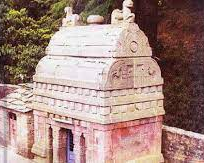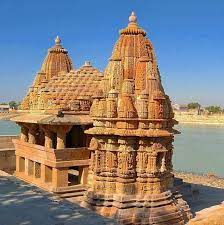Indian Heritage & Culture
Ram Temple
- 23 Jan 2024
- 14 min read
For Prelims: Liberhan Commission, Supreme Court, Girmitiya Migration, 00 Year Old Journey of Ram Temple, Nagara Style of Temple Architecture.
For Mains: 200-Year-Old Journey of Ram Temple.
Why in News?
On 22nd January 2024, the Ram temple in Ayodhya was inaugurated, marking the completion of a 200-year-old saga that profoundly impacted India's socio-political landscape.
- The Ram temple has been designed in the Nagara Style of Temple Architecture.
- The story of Ram is popular from Laos, Cambodia and Thailand in Asia to Guyana in South America to Mauritius in Africa, making Ramayana Popular outside India.
What is the Timeline of Ram Janmabhoomi Movement?
- Origin:
- Originating in 1751 when the Marathas appealed to the Nawab of Awadh (Nawab Shuja-ud-Daula) for control of Ayodhya, Kashi, and Mathura.
-
The Marathas had helped the Nawab of Awadh in defeating the Pathan (local chieftain) forces in the Doab Region and as a result, they sought control over these important religious and cultural centres like Ayodhya, Kashi (Varanasi), and Mathura.
-
The Doab Region refers to the area between the Ganges and Yamuna rivers in northern India.
-
-
The movement gained momentum in the 19th century with judicial records dating back to 1822 mentioning a mosque on the birthplace of Lord Ram.
- Clash Near Babri Masjid:
- Tensions escalated in 1855 with a violent clash near the Babri Masjid between Hindus and Muslims, leading to the capture of Janmasthan by Hindus.
- Placement of the idol of Ram Lalla:
- The year 1949 saw the placement of the idol of Ram Lalla in the mosque, sparking demands for a grand temple.
- Legal Battles:
- In the 1980s, the Vishwa Hindu Parishad (VHP) initiated a movement for the 'liberation' of Ram Janmabhoomi, Krishna Janmabhoomi, and Vishwanath shrine.
- Legal battles ensued, and in 1986, the locks of the Babri Masjid were opened, allowing Hindus to offer prayers.
- The following years witnessed significant events, including the foundation-laying ceremony in 1989 and the Rath Yatra led by LK Advani in 1990, leading to widespread riots.
- Demolition of Babri Masjid:
- On 6th December 1992, a mob demolished the Babri Masjid, leading to political repercussions and legal proceedings.
- In 1993, Parliament passed the Acquisition of Certain Area at Ayodhya Act, allowing the government to acquire the disputed Ram Janmabhoomi-Babri Masjid land.
- The Liberhan Commission, in 2009, highlighted the premeditated nature of the events in 1992.
- Allahabad High Court Verdict:
- In 2010, a special bench of the Allahabad High Court in its Ayodhya title suit judgment divided the land in a 2:1 ratio, with two-thirds of the 2.77-acre, including the garbha griha, going to litigants for a Ram temple – Shri Ram Lala Virajman and Nirmohi Akhara.
- One-third of the land was given to the Sunni Central Waqf Board.
- Supreme Court Verdict:
- Legal proceedings continued, and in 2019, the Supreme Court awarded the entire disputed land to the Hindu petitioners for a Ram temple and allocated land for a mosque elsewhere.
- Culmination:
- The culmination of this historic journey occurred on 5th August, 2020, when the Indian Prime Minister performed the Shilanyas of the Ram temple, establishing the Shri Ram Janmabhoomi Teerth Kshetra Trust.
- On 22nd January 2024, the Ram temple in Ayodhya, built in Nagara Style, was set to be inaugurated, marking the completion of a 200-year-old saga that profoundly impacted India's socio-political landscape.
What is the Uniqueness of Ram Temple?
- Traditional Architecture and Construction:
- This is a 3-storey temple, built in the traditional Nagara style, standing tall with pink sandstone from Mirzapur and the hills of Bansi-Paharpur (Rajasthan).
- Temple covers an expansive 71 acres, showcasing the architectural marvel.
- Temple Dimensions:
- Spanning 250 feet in width and 161 feet in height, the main temple area covers 2.67 acres, boasting 390 pillars, 46 doorways, and 5 mandaps.
- Unique Features Inside:
- The main Garbh Griha holds the idols of Ram Lalla, accompanied by multiple mandaps, including Rang Mandap & Nritya Mandap.
- Innovative Anointment Tradition:
- On every Ram Navami at noon, a system of mirrors and lenses will focus the sun's rays on Ram Lalla’s idol. This unique anointment requires no electricity, utilizing brass instead of iron or steel.
- Sculptor's Contribution:
- The idol of five-year-old Ram Lalla, crafted by Mysuru sculptor Arun Yogiraj, stands at 51 inches and was consecrated in a special ceremony.
- Durability and Symbolism:
- No iron has been used in the temple's construction, designed to endure for at least a millennium.
What is the Nagara Style of Temple Architecture?
- About:
- The Nagara style of temple architecture emerged sometime in the 5th century CE, during the late Gupta period, in northern India.
- It is seen in juxtaposition with the Dravida style of southern India, which too emerged in the same period.
- Distinguished by a Towering Shikhara:
- Nagara temples are built on a raised plinth, with the Garbha Griha (sanctum sanctorum) — where the idol of the deity rests — the most sacred part of the temple.
- Towering over the Garbha Griha is the shikhara (literally ‘mountain peak’), the most distinguishable aspect of Nagara-style temples.
- As the name suggests, shikharas are human-made representations of the natural and cosmological order, as imagined in Hindu tradition.
- A typical Nagara-style temple also comprises a circumambulatory passage around the garbha griha, and one or more mandapas (halls) on the same axis as it. Elaborate murals and reliefs often adorn its walls.
Note
- Meru, Mandara and Kailasa are the first three names amongst the twenty types of temples described in the early texts, all three are the names of the Mountain, which is the axis of the world.
- Five Modes of Nagara Architecture:
- Valabhi:
- Phamsana:
- Latina:
- The Latina is a shikhara that is a single, slightly curved tower with four sides of equal length. It emerged in the Gupta heartland, was complete with curvature by the early seventh century, and spread across the entire breadth of northern India. For three centuries, it was considered the peak of Nagara temple architecture.

- The Latina is a shikhara that is a single, slightly curved tower with four sides of equal length. It emerged in the Gupta heartland, was complete with curvature by the early seventh century, and spread across the entire breadth of northern India. For three centuries, it was considered the peak of Nagara temple architecture.
- Shekhari:
- Bhumija:
- The Bhumija mode involves miniature spires arranged in horizontal and vertical rows, creating a grid-like effect on each face of the shikhara. The actual shikhara often approaches a pyramidal shape, with the curve of the Latina less visible. This style emerged from composite Latinas in the tenth century onwards.

- The Bhumija mode involves miniature spires arranged in horizontal and vertical rows, creating a grid-like effect on each face of the shikhara. The actual shikhara often approaches a pyramidal shape, with the curve of the Latina less visible. This style emerged from composite Latinas in the tenth century onwards.
How has Shri Ram and Ramayana Become Popular Outside India?
- Trade Routes and Cultural Exchange:
- The Ramayana spread through trade routes, both by land and sea. Indian traders, travelling for commerce, carried with them not only goods but also cultural elements, including religious stories.
- Land routes, such as the northern route through Punjab and Kashmir, and the eastern route through Bengal, facilitated the transmission of the Ramayana to regions like China, Tibet, Burma, Thailand, and Laos.
- Sea routes, particularly the southern route from Gujarat and South India, led to the dissemination of the epic in places like Java, Sumatra, and Malaya.
- Cultural Transmission by Indian Communities:
- Indian traders, accompanied by Brahmin priests, Buddhist monks, scholars, and adventurers, played a crucial role in transmitting Indian culture, traditions, and philosophy to the people of Southeast Asia.
- Over time, the Ramayana became an integral part of the culture of many Southeast Asian countries, influencing art, architecture, and religious practices.
- Integration into Local Culture:
- The Ramayana integrated with local cultures in various ways. For example, in Thailand, the Ayutthaya kingdom is believed to have been based on the Ayodhya of the Ramayana.
- In Cambodia, the Angkor Wat temple complex, originally dedicated to Vishnu, features murals depicting scenes from the Ramayana.
- Evolution of the Epic:
- The Ramayana took on local flavors and variations in different regions. For instance, the Ramakien in Thailand, influenced by the Tamil epic Kamban Ramayana, became Thailand's national epic.
- Various adaptations in different countries incorporated unique elements, such as the depiction of characters with Tamil names in the Thai Ramakien.
- Spread Through Indentured Labor Migration:
- In the 19th century, the Girmitiya Migration resulted in the spread of the Ramayana to regions like Fiji, Mauritius, Trinidad and Tobago, Guyana, and Suriname.
- Indentured laborers carried their cultural and religious practices, including the Ramcharitmanas, with them to new lands.
- Enduring Themes and Universality:
- The Ramayana served as a source of cultural identity and nostalgia for Indian communities living far away from their homeland. It provided a connection to their roots and a sense of familiarity in alien lands.
- The themes of the Ramayana, such as the triumph of good over evil, the concept of dharma, and the narrative of exile and return, resonate universally, making the epic relatable to diverse cultures.
- Continued Cultural Practices:
- Even today, the Ramayana remains a significant part of the cultural fabric in many Southeast Asian countries. It is kept alive through various art forms, including plays, dance dramas, puppet shows, and religious ceremonies.
UPSC Civil Services Examination Previous Year Question (PYQ)
Prelims
Q. The Nagara, the Dravida and the Vesara are the (2012)
(a) three main racial groups of the Indian subcontinent
(b) three main linguistic divisions into which the languages of India can be classified
(c) three main styles of Indian temple architecture
(d) three main musical Gharanas prevalent in India
Ans: c
Mains
Q. Chola architecture represents a high watermark in the evolution of temple architecture. Discuss (2013)
Q. Indian philosophy and tradition played a significant role in conceiving and shaping the monuments and their art in India. Discuss. (2020)










